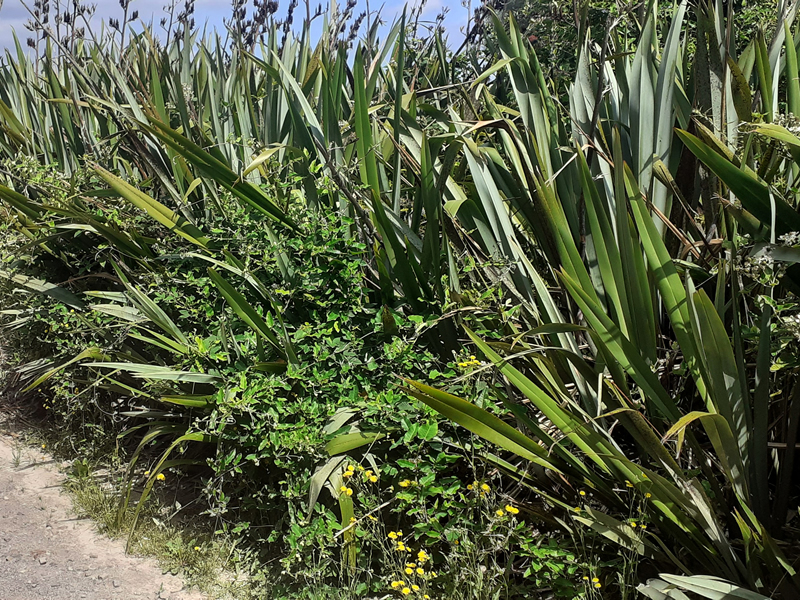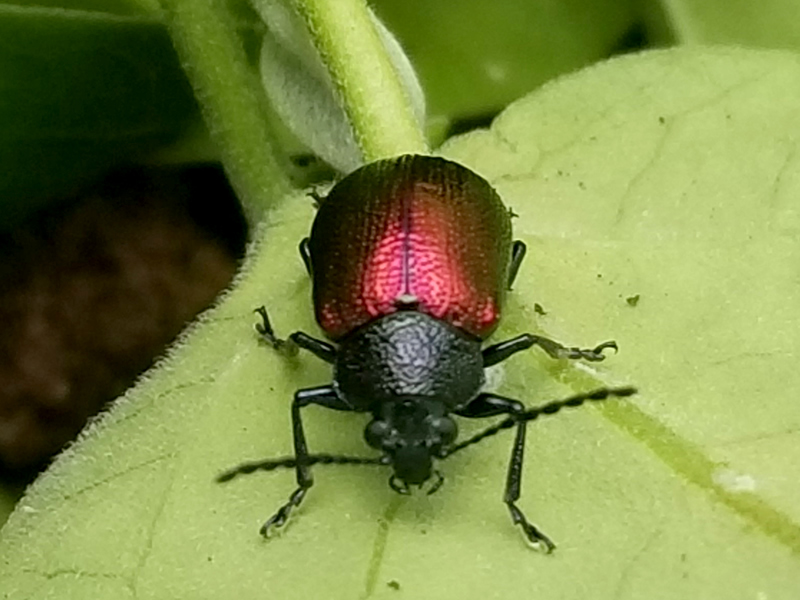Introducing the moth plant beetle, at last!
We are very excited to report that the first releases of the moth plant beetle (Freudeita cupripennis) took place in December 2019 at sites in the Bay of Plenty and Northland. One hundred and fifty adult beetles were released on 13 December at Matapihi, near Tauranga, in the Bay of Plenty. Shane Hona (Bay of Plenty Regional Council), together with Hayden Henry, a representative of Ngai Tukairangi Resource Management Authority, released the beetles onto a moth plant infestation smothering harakeke/New Zealand flax (Phormium tenax). The second release, also consisting of 150 adult beetles, took place in the Awanui area near the Sweetwater Lakes in Northland, courtesy of Jenny Dymock (Northland Regional Council). Jenny conducted the release on 18 December as part of Bushland Trust’s restoration plan for the lakes and the surrounding riparian/run-off zones.

Moth plant (Araujia hortorum) is native to Brazil, Argentina, Paraguay and Uruguay and is particularly invasive in the northern regions of New Zealand. The vines of moth plant smother shrubs and small trees, and they spread along the ground, shading out small native plants and seedlings. Moth plant is currently dominant in urban and peri-urban areas, particularly around forest margins, hedges and wastelands, but in time it will pose a greater threat to healthy native forests in northern New Zealand. Moth plant’s choko-like fruits produce 250 to 1,000 parachute-like seeds, which can disperse long distances in the wind. When damaged, moth plant exudes a white, waxy substance, which can stain clothing and with direct contact can cause skin irritation and serious eyes problems. Moth plant is so disliked in New Zealand that communities and school groups are dedicated to its demise. The Society Totally Against Moth Plant (STAMP), which has close to 500 members on Facebook, regularly goes on “control adventures” in the Auckland region. Moth plant is also subject to interschool competitions, whereby teams vie to collect the highest number of pods, with the winner taking home prize money donated by Pest Free Auckland. In 2019 two teams from Botany College finished in first and second place, with Team Demons defeating The Cultured Moth Destroyers by a score of 2,265 to 1,878 moth plant pods.
The release of the moth plant beetle has been a long time coming. An application to release the beetles was first approved by the Environmental Protection Authority (EPA) in December 2011, but due to ongoing problems with exporting biocontrol agents from Argentina, the beetles had to be recollected from Uruguay and undergo a new batch of host specificity tests. The beetle population from the Melilla area, northwest of Montevideo, was approved for release by the EPA in May 2019, after which Zane McGrath, the technician on the project, worked very hard to build up beetle numbers for a release. According to Zane, “the beetles are a bit of a handful to rear in the lab, but in a good way. When first rearing the beetles, we left groups of adults on individual potted moth plants, until we noticed that the plants started dying due to the hundreds of larvae that were feeding on the roots of the plants, causing them considerable damage and stress. We had to adjust our rearing techniques to control the numbers of larvae per plant to ensure enough root material for all of them to complete their development to adulthood.”

Hopefully the beetle larvae will have just as voracious an appetite for moth plant in the field as they do in the lab. “Although it is early days, the adult beetles, which are about 1 cm in length, should be easy to spot in the field, with their impressive metallic red wing cases and distinctive black head, thorax, antennae and legs,” said Zane. The beetles are expected to have two to three generations per year in New Zealand. “Further releases of the beetles are planned this summer, before they slow down to enter diapause, a period of suspended development to survive the colder months,” said Zane.
Bay of Plenty Regional Council release the moth beetle in a world first
This project is funded by the National Biocontrol Collective.
